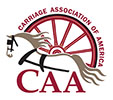
In 1952, The Quiet Man, starring John Wayne and Maureen O’Hara re-introduced the Jaunting Car to the world when they went courting in the horse drawn cart. Long before the movie, there was another romance that resulted in the Jaunting Car being the most recognizable Irish cart.
In 1786, Charles Bianconi was born in Italy. As a young man he met and fell in love with a wealthy young woman who was already promised to another. Going off to make his fortune in Ireland, Charles was determined to equal or surpass the wealth of her family. He eventually set up a engraving and print shop, soon he had enough money to buy his first horse-drawn vehicle, a yellow gig with high wheels pulled by a grey mare. Having spent years walking everywhere, Bianconi was quick to see the advantages, as a businessman, to having access to horse drawn transportation. Suddenly trips that used to take him two days (causing him to lose business on those days) took him a day. Public transportation was nonexistent, private vehicles were highly taxed and river boats didn’t always go where you needed to go.
“On the momentous summer day of 6th July 1815 the first Bianconi car took the road from Clonmel to Cahir, and for the first time Charles Bianconi carried His Majesty’s mails in Ireland.”1 The daily trip traveled 7 1/2 miles per hour, with passengers being prepared to exit the two-wheeled Outside Car (aka a Jaunting Car) to traverse the steep hill in between the two towns. The fare was two pence per mile. Disaster loomed as country folks declined the ride. Then Bianconi had a stroke of brilliance – he set up another company under another name to compete with the original business. The drivers battled for passengers, creating excitement and interest. Soon people had become accustomed to riding in Jaunting Cars and the second business faded away.
Charles Bianconi became very well known in Ireland and made a fortune. He never forgot his first love though and was devastated to learn that she had indeed married another. All was not lost though on the romance front with Bianconi eventually marrying the daughter of a friend.

In the world of transportation, Charles Bianconi was a powerhouse and he is recognized as the ‘father of public transportation’ in Ireland. Choosing a Jaunting Car as the first mass transport vehicle in Ireland sealed its fate as being instantly recognizable as an Irish vehicle. So what is it that makes a Jaunting Car a Jaunting Car?
Looking at Carriages by Sallie Walrond identifies two types of Jaunting Cars – with and without a central seat, with the most common type not having a central seat. Passengers on both types sit facing outward, the side foot-rests are typically hinged allowing them to be collapsed when going through narrow openings. Bianconi’s vehicles were known to have horse-hair cushions, which were changed every two stages in wet weather.2 Many early vehicles did not have springs and thus were built low to the ground. Later vehicles often sport long double-elbowed springs and are much higher off the ground. All were built on straight wooden axles.
“The backs of the two seats form a narrow well, as it is termed, for the storage of luggage in the center, a name by no means inappropriate, as it is generally full of water when it rains,” reports a recent traveler in Ezra Statton’s The World on Wheels. Riding in one was by many reports a bit like riding in a Tilt-A-Whirl, going up a hill everyone leaned into the last person, doing down the first person was leaned on. Learning to balance a Jaunting Car properly required skill and skilled drivers became very adapt at guessing the weigh of a passenger. A driver was often called a “jarvey” and several songs have been written about them.
 Slightly less known is that there were four wheeled versions of Jaunting Cars. The larger vehicles were used by Bianconi and were typically pulled by four horses, much like a stagecoach. A few carriage makers tried duplicating the success of the Jaunting Car, both two and four wheeled, in other countries but they were never popular outside Ireland.
Slightly less known is that there were four wheeled versions of Jaunting Cars. The larger vehicles were used by Bianconi and were typically pulled by four horses, much like a stagecoach. A few carriage makers tried duplicating the success of the Jaunting Car, both two and four wheeled, in other countries but they were never popular outside Ireland.
In addition to commercial use Jaunting Cars were used as private transportation.

To learn more about the Irish Jaunting Car we recommend reading Bianconi: King of the Irish Roads by M. O’C. Bianconi and S.J. Watson. The Hub, May 1887 has additional information on how the shafts and body of the vehicle were made. The Irish Cars by Tom Ryder is another resource, the article was published in the May 2006 edition of The Carriage Journal. The Origin of the Irish Jaunting Car by James Young originally was published in The Hub but reprinted in the Spring 1977 edition of The Carriage Journal. Additionally Horses in the Morning has a podcast that includes Jaunting Cars.
Resources:
- Bianconi: King of the Irish Roads by M. O’C. Bianconi and S.J. Watson
- The World on Wheels by Ezra Statton


